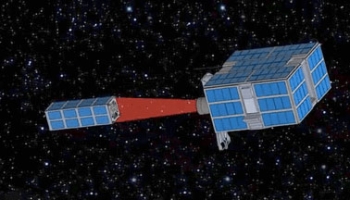Michael Veto, a third-year graduate student in the School of Earth and Space Exploration (SESE) at Arizona State University, has been chosen to build an infrared and visible light camera system that will launch on a space satellite. Veto, who earned his undergraduate degree in aerospace engineering at ASU, is a geology doctoral student of Philip Christensen, Regents' Professor of Geological Sciences in ASU's College of Liberal Arts and Sciences.
 ASU's infrared and visual camera will track the cubesat as it is launched from the Prox-1 spacecraft. Photo by: Georgia Institute of Technology
ASU's infrared and visual camera will track the cubesat as it is launched from the Prox-1 spacecraft. Photo by: Georgia Institute of Technology
The new camera will play a central role in the payload for the Prox-1 satellite, which won the seventh University Nanosat Program (UNP) competition, sponsored by the Air Force Office of Scientific Research and the Air Force Research Laboratory. It will be constructed in a cleanroom at SESE's new Interdisciplinary Science and Technology Building 4 on the Tempe campus.
The Prox-1 mission is designed by students at the Georgia Institute of Technology under the guidance of professor David Spencer, within Georgia Tech's Center for Space Systems. It will demonstrate automated trajectory control in low-Earth orbit relative to a deployed sub-satellite, or cubesat.
The flight plan calls for Prox-1 to release this smaller spacecraft, which is a version of The Planetary Society’s LightSail solar sail spacecraft. (A solar sail uses the pressure of sunlight for low-thrust propulsion.) Then using the ASU camera's images to guide its trajectory, Prox-1 will fly in formation with the LightSail spacecraft. The ASU camera will also take images of the LightSail solar sail as it opens.
In addition to demonstrating automated proximity operations, Prox-1 will provide first-time flight validation of advanced sun sensor technology, a small satellite propulsion system, and a lightweight thermal imager.
As the winner of the UNP competition, the Prox-1 mission will receive an Air Force launch slot as a secondary payload plus additional development funding over the next two years. The Prox-1 team will complete spacecraft integration and testing, working toward a launch in 2015.
In addition to support from the U.S. Air Force, the Prox-1 team has been supported by contributions from the Georgia Space Grant Consortium, The Aerospace Corporation, Raytheon Vision Systems, and the Jet Propulsion Laboratory.